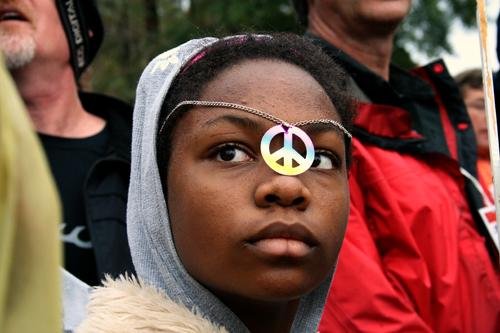Thousands of protesters, including 32 representatives from Loyola, gathered in Fort Benning, Ga. Sunday, Nov. 22 to congregate a peaceful protest against the U.S. Department of Defense’s formerly known School of the Americas.
Loyola students and staff, each holding a white wooden cross with the name of a victim connected to the School of the Americas, stood outside its fence along with the other protestors.
Students Seeking Solidarity, a subgroup of the Loyola University Community Action Program, plans the trip to the protest each year. The advocacy organization School of the Americas Watch organizes the annual protest to call for the closing of the combat training school (renamed the Western Hemisphere Institute for Security Cooperation in 2001).
School of the Americas Watch and other critics say the school’s graduates have committed murders, rapes and tortures in Latin America, including a 1989 massacre of six Jesuit priests in El Salvador. Military officials strongly deny that the School of the Americas or its successor were responsible for any human-rights abuses. A U.S. congressional panel concluded that some of the killers in the 1989 massacre were School of America graduates.
There were speakers who talked about their experiences. Most speakers were activists and representatives from the School of the Americas Watch, talking to the audience in the rain. One of the speakers was a family member of a victim, who cried through half of her speech.
Every 15 minutes or so, Loyola Law professor Bill Quigley’s phone number for legal services was given through the microphone for anyone who crossed the three fences into the school, resulting in their arrest. Quigley, director of Loyola’s Law Clinic and well as the Gillis Long Poverty Law Center, served as the volunteer attorney for the protest.
The vigil was lead by a group dressed in hooded, black robes with white powdered faces who emerged from the crowd of thousands just minutes before the march started. Some were holding white crosses, others carrying black coffins. Behind them stood a small crowd of people holding tall, bamboo reeds with ribbons hanging from the ends.
The announcers chanted the names and ages of victims while the crowd responded by raising their crosses and chanting “presente,” the Spanish word for “present.”
“I was really moved by the chanting of names during the protest,” said sociology sophomore Jill Douglas. “I liked the respectfulness of the crowd toward the victims.”
The drummers eventually made their way to the front where they joined the hooded figures and prepared to lead the march, their steady drumming continuous throughout the march. A group of puppetistas trailed after them, the first person sporting a giant blue paper mache head with a blue face, supported by a series of sticks which lay hidden behind the puppet’s black dress. The puppetistas who followed later in the march represented the six Jesuit priests and had equally big faces as the one that preceded them, yet the color of these more closely resembled human skin. These last few dressed in white and had the company of boys dressed as altar boys.
The procession ended at noon, but by then LUCAP had decided to return to New Orleans. “I really didn’t like that we had to cut out early,” says sociology sophomore Ellen Rice. “I think it’s very powerful to put the cross in the gate and look back at the crowd’s emotional reaction, so I was very disappointed to miss that.”
Prior to the Sunday vigil, students and staff also attend the Ignatian Family Teach-In for Justice on Friday and Saturday, in which different speakers, including Quigley, discussed different social justice issues.
“He really brought to light a whole new perspective of what ‘social justice’ really means,” said Rolando Lopez, English writing sophomore and co-chair of Students Seeking Solidarity.
“If you have come here to help me, you are wasting your time. If you have come here because your liberation is bound up in mine, then let us work together to make a change,” Quigley said, his words almost drowned out by applause.
Even though the Teach-In had its share of crowd-pleasing speakers, some found the back-to-back speeches to be overwhelming and disheartening. “I get really antsy and some of the speeches were so long I had trouble paying attention,” says Douglas.
The speeches concluded on Saturday with a Mass. Music junior and co-chair of Students Seeking Solidarity Annie Halbert was among the guest vocalists in the Mass who earned a standing ovation from the crowd at the end.
“I really enjoyed the mass because its emotional effect shows how powerful a group of people can be,” said Rice. “There’s so much energy you come out with a high.”
The Associated Press contributed to this report. Geenah Acevedo can be reached at gmaceved@loyno.edu






